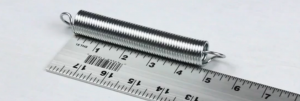Easy Adjustments to Prevent Extension Spring Failure

The primary areas of vulnerability with an extension spring are the ends, while the body tends to be more stable. The wire is bent upward to form the end loops or hooks. This results in the diameter at the ends being slightly decreased, creating a considerable concentration of stress. Properly designed extension springs compensate for this vulnerability.
It is essential to gather accurate data during the design phase to know what will be required of the spring. This will greatly reduce the chances of extension spring failure. Data will typically include the required extended length to the necessary load or the full measurements of an existing spring. The more exact the details you have, the less likely spring over-stressing and breakage will occur.
See how to measure an extension spring.
Need assistance with an extension spring design adjustment or other spring failure problem? Our spring design experts are here to help.
 LinkedIn
LinkedIn